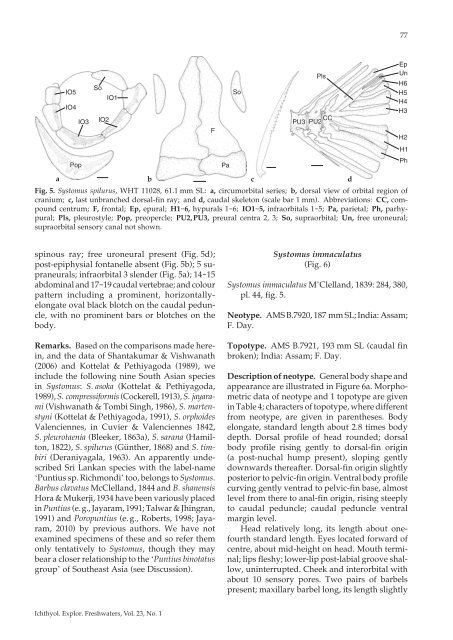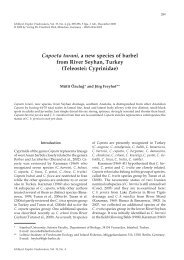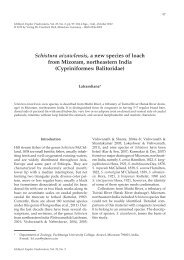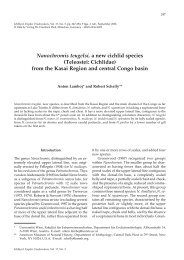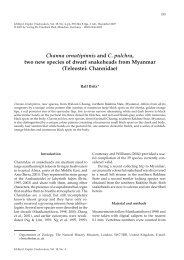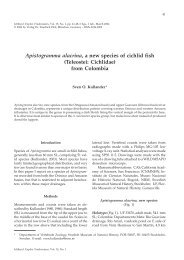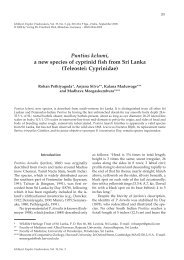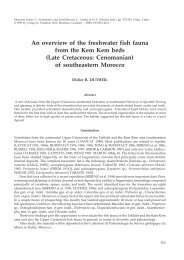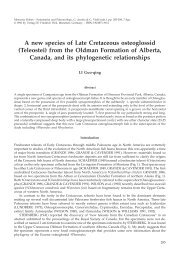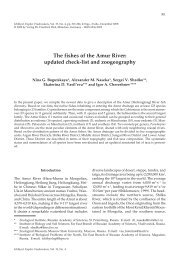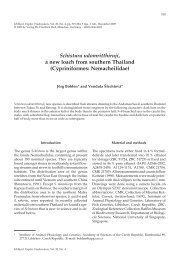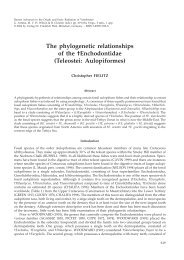A synopsis of the South Asian fishes referred to Puntius - Verlag Dr ...
A synopsis of the South Asian fishes referred to Puntius - Verlag Dr ...
A synopsis of the South Asian fishes referred to Puntius - Verlag Dr ...
You also want an ePaper? Increase the reach of your titles
YUMPU automatically turns print PDFs into web optimized ePapers that Google loves.
IO5<br />
IO4<br />
Pop<br />
So<br />
IO3 IO2<br />
IO1<br />
a b c d<br />
Ichthyol. Explor. Freshwaters, Vol. 23, No. 1<br />
F<br />
Pa<br />
So<br />
Pls<br />
PU3 PU2 CC<br />
PU3 PU2 CC<br />
Fig. 5. Sys<strong>to</strong>mus spilurus, WHT 11028, 61.1 mm SL: a, circumorbital series; b, dorsal view <strong>of</strong> orbital region <strong>of</strong><br />
cranium; c, last unbranched dorsal-fin ray; and d, caudal skele<strong>to</strong>n (scale bar 1 mm). Abbreviations: CC, compound<br />
centrum; F, frontal; Ep, epural; H1-6, hypurals 1-6; IO1-5, infraorbitals 1-5; Pa, parietal; Ph, parhypural;<br />
Pls, pleurostyle; Pop, preopercle; PU2, PU3, preural centra 2, 3; So, supraorbital; Un, free uroneural;<br />
supraorbital sensory canal not shown.<br />
spinous ray; free uroneural present (Fig. 5d);<br />
post-epiphysial fontanelle absent (Fig. 5b); 5 supraneurals;<br />
infraorbital 3 slender (Fig. 5a); 14-15<br />
abdominal and 17-19 caudal vertebrae; and colour<br />
pattern including a prominent, horizontallyelongate<br />
oval black blotch on <strong>the</strong> caudal peduncle,<br />
with no prominent bars or blotches on <strong>the</strong><br />
body.<br />
Remarks. Based on <strong>the</strong> comparisons made herein,<br />
and <strong>the</strong> data <strong>of</strong> Shantakumar & Vishwanath<br />
(2006) and Kottelat & Pethiyagoda (1989), we<br />
include <strong>the</strong> following nine <strong>South</strong> <strong>Asian</strong> species<br />
in Sys<strong>to</strong>mus: S. asoka (Kottelat & Pethiyagoda,<br />
1989), S. compressiformis (Cockerell, 1913), S. jayarami<br />
(Vishwanath & Tombi Singh, 1986), S. martenstyni<br />
(Kottelat & Pethiyagoda, 1991), S. orphoides<br />
Valenciennes, in Cuvier & Valenciennes 1842,<br />
S. pleurotaenia (Bleeker, 1863a), S. sarana (Hamil<strong>to</strong>n,<br />
1822), S. spilurus (Gün<strong>the</strong>r, 1868) and S. timbiri<br />
(Deraniyagala, 1963). An apparently undescribed<br />
Sri Lankan species with <strong>the</strong> label-name<br />
‘<strong>Puntius</strong> sp. Richmondi’ <strong>to</strong>o, belongs <strong>to</strong> Sys<strong>to</strong>mus.<br />
Barbus clavatus McClelland, 1844 and B. shanensis<br />
Hora & Mukerji, 1934 have been variously placed<br />
in <strong>Puntius</strong> (e. g., Jayaram, 1991; Talwar & Jhingran,<br />
1991) and Poropuntius (e. g., Roberts, 1998; Jayaram,<br />
2010) by previous authors. We have not<br />
examined specimens <strong>of</strong> <strong>the</strong>se and so refer <strong>the</strong>m<br />
only tentatively <strong>to</strong> Sys<strong>to</strong>mus, though <strong>the</strong>y may<br />
bear a closer relationship <strong>to</strong> <strong>the</strong> ‘<strong>Puntius</strong> binotatus<br />
group’ <strong>of</strong> Sou<strong>the</strong>ast Asia (see Discussion).<br />
Sys<strong>to</strong>mus immaculatus<br />
(Fig. 6)<br />
77<br />
Ep<br />
Un<br />
H6<br />
H5<br />
H4<br />
H3<br />
H2<br />
H1<br />
Ph<br />
Sys<strong>to</strong>mus immaculatus M’Clelland, 1839: 284, 380,<br />
pl. 44, fig. 5.<br />
Neotype. AMS B.7920, 187 mm SL; India: Assam;<br />
F. Day.<br />
Topotype. AMS B.7921, 193 mm SL (caudal fin<br />
broken); India: Assam; F. Day.<br />
Description <strong>of</strong> neotype. General body shape and<br />
appearance are illustrated in Figure 6a. Morphometric<br />
data <strong>of</strong> neotype and 1 <strong>to</strong>potype are given<br />
in Table 4; characters <strong>of</strong> <strong>to</strong>potype, where different<br />
from neotype, are given in paren<strong>the</strong>ses. Body<br />
elongate, standard length about 2.8 times body<br />
depth. Dorsal pr<strong>of</strong>ile <strong>of</strong> head rounded; dorsal<br />
body pr<strong>of</strong>ile rising gently <strong>to</strong> dorsal-fin origin<br />
(a post-nuchal hump present), sloping gently<br />
downwards <strong>the</strong>reafter. Dorsal-fin origin slightly<br />
posterior <strong>to</strong> pelvic-fin origin. Ventral body pr<strong>of</strong>ile<br />
curving gently ventrad <strong>to</strong> pelvic-fin base, almost<br />
level from <strong>the</strong>re <strong>to</strong> anal-fin origin, rising steeply<br />
<strong>to</strong> caudal peduncle; caudal peduncle ventral<br />
margin level.<br />
Head relatively long, its length about onefourth<br />
standard length. Eyes located forward <strong>of</strong><br />
centre, about mid-height on head. Mouth terminal;<br />
lips fleshy; lower-lip post-labial groove shallow,<br />
uninterrupted. Cheek and interorbital with<br />
about 10 sensory pores. Two pairs <strong>of</strong> barbels<br />
present; maxillary barbel long, its length slightly


